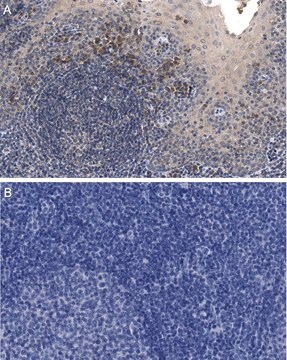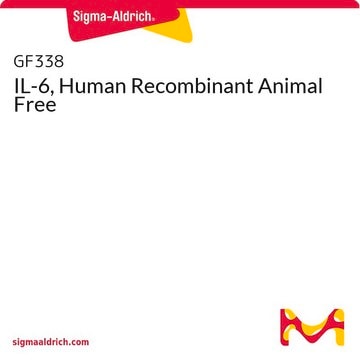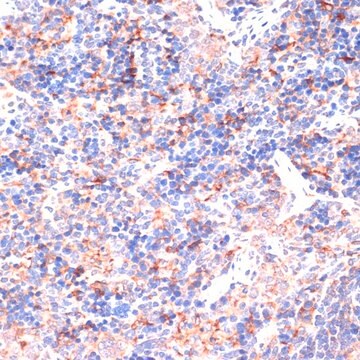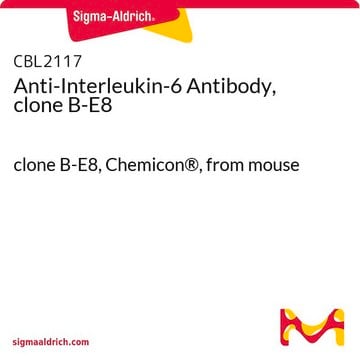AB1839
Anti-Interleukin-6 Antibody
serum, Chemicon®
Sinónimos:
IL-6
Iniciar sesiónpara Ver la Fijación de precios por contrato y de la organización
About This Item
Código UNSPSC:
12352203
eCl@ss:
32160702
NACRES:
NA.41
Productos recomendados
origen biológico
rabbit
Nivel de calidad
forma del anticuerpo
serum
tipo de anticuerpo
primary antibodies
clon
polyclonal
reactividad de especies
sheep
fabricante / nombre comercial
Chemicon®
técnicas
ELISA: suitable
western blot: suitable
Nº de acceso NCBI
Nº de acceso UniProt
Condiciones de envío
dry ice
modificación del objetivo postraduccional
unmodified
Información sobre el gen
sheep ... Il6(443406)
Especificidad
Reacts with ovine IL-6. No reactivity detected to recombinant ovine IL-1beta, IL-8, MCP or TNFalpha.
Inmunógeno
Recombinant ovine IL-6
Aplicación
Anti-Interleukin-6 Antibody is an antibody against Interleukin-6 for use in ELISA & WB.
Detecting antibody in ELISA, using monoclonal anti-ovine IL-6 as capture antibody. Recommended dilution factor 1:500. See suggested protocol.
Western Blot
Optimal working dilutions must be determined by the end user.
Suggested ELISA Protocol For Ovine IL-6
1. Coat high capacity microtitre wells (e.g. Nunc maxisorp) with monoclonal anti-IL-6 antibody (Chemicon Catalog Number MAB1004) at a concentration of 5 μg/mL in 0.1 M carbonate buffer pH 9.6 overnight at 4ºC.
2. Wash wells 3 x with PBS + 0.05% Tween 20 (PBST).
3. Add samples to wells. Incubate at room temperature in a humidified box for 1 hour. Wash 3 x with PBST.
4. Dilute rabbit anti-IL-6 (Chemicon Catalog Number AB1839) 1:500 in PBST and add 100 μL to wells. Incubate at room temperature for 30 minutes. Wash 3 x with PBST.
5. Dilute anti-rabbit IgG-HRP to appropriate level in PBST and add 100 μL to wells. Incubate 30 minutes at room temperature. Wash 3 x with PBST.
6. Add 100 μL of TMB chromagen to each well. Incubate for 5-10 minutes and stop reaction with 50 μL of 2M sulphuric acid.
Notes:
The anti-rabbit IgG HRP must be adsorbed against mouse immunoglobulin, and should be checked for non-reactivity with coated plates.
Non-specific binding may be reduced by addition of protein such as skim milk powder to the diluents.
Assay sensitivity may be altered by adjusting incubation times and reagent concentrations.
Western Blot
Optimal working dilutions must be determined by the end user.
Suggested ELISA Protocol For Ovine IL-6
1. Coat high capacity microtitre wells (e.g. Nunc maxisorp) with monoclonal anti-IL-6 antibody (Chemicon Catalog Number MAB1004) at a concentration of 5 μg/mL in 0.1 M carbonate buffer pH 9.6 overnight at 4ºC.
2. Wash wells 3 x with PBS + 0.05% Tween 20 (PBST).
3. Add samples to wells. Incubate at room temperature in a humidified box for 1 hour. Wash 3 x with PBST.
4. Dilute rabbit anti-IL-6 (Chemicon Catalog Number AB1839) 1:500 in PBST and add 100 μL to wells. Incubate at room temperature for 30 minutes. Wash 3 x with PBST.
5. Dilute anti-rabbit IgG-HRP to appropriate level in PBST and add 100 μL to wells. Incubate 30 minutes at room temperature. Wash 3 x with PBST.
6. Add 100 μL of TMB chromagen to each well. Incubate for 5-10 minutes and stop reaction with 50 μL of 2M sulphuric acid.
Notes:
The anti-rabbit IgG HRP must be adsorbed against mouse immunoglobulin, and should be checked for non-reactivity with coated plates.
Non-specific binding may be reduced by addition of protein such as skim milk powder to the diluents.
Assay sensitivity may be altered by adjusting incubation times and reagent concentrations.
Research Category
Inflammation & Immunology
Inflammation & Immunology
Research Sub Category
Cytokines & Cytokine Receptors
Cytokines & Cytokine Receptors
Ligadura / enlace
Replaces: 04-1095
Forma física
Rabbit serum. Liquid containing 0.1% sodium azide.
Almacenamiento y estabilidad
Maintain at -20°C in undiluted aliquots for up to 12 months. Avoid repeated freeze/thaw cycles.
Información legal
CHEMICON is a registered trademark of Merck KGaA, Darmstadt, Germany
Cláusula de descargo de responsabilidad
Unless otherwise stated in our catalog or other company documentation accompanying the product(s), our products are intended for research use only and are not to be used for any other purpose, which includes but is not limited to, unauthorized commercial uses, in vitro diagnostic uses, ex vivo or in vivo therapeutic uses or any type of consumption or application to humans or animals.
Not finding the right product?
Try our Herramienta de selección de productos.
Código de clase de almacenamiento
10 - Combustible liquids
Clase de riesgo para el agua (WGK)
WGK 2
Certificados de análisis (COA)
Busque Certificados de análisis (COA) introduciendo el número de lote del producto. Los números de lote se encuentran en la etiqueta del producto después de las palabras «Lot» o «Batch»
¿Ya tiene este producto?
Encuentre la documentación para los productos que ha comprado recientemente en la Biblioteca de documentos.
Tate Gisslen et al.
Innate immunity, 20(2), 214-224 (2013-06-12)
Histologic chorioamnionitis, frequently associated with preterm births and adverse outcomes, results in prolonged exposure of preterm fetuses to infectious agents and pro-inflammatory mediators, such as LPS. Endotoxin tolerance-type effects were demonstrated in fetal sheep following repetitive systemic or intra-amniotic (i.a.)
Gunlawadee Maneenil et al.
PloS one, 10(3), e0119281-e0119281 (2015-03-21)
A fetal inflammatory response (FIR) in sheep can be induced by intraamniotic or selective exposure of the fetal lung or gut to lipopolysaccharide (LPS). The oral, nasal, and pharyngeal cavities (ONP) contain lymphoid tissue and epithelium that are in contact
Modulation of lipopolysaccharide-induced chorioamnionitis by Ureaplasma parvum in sheep.
Snyder, CC; Wolfe, KB; Gisslen, T; Knox, CL; Kemp, MW; Kramer, BW; Newnham, JP; Jobe et al.
American Journal of Obstetrics and Gynecology null
Clare A Berry et al.
Reproductive sciences (Thousand Oaks, Calif.), 18(11), 1092-1102 (2011-04-16)
We tested the hypothesis that interleukin 1 (IL-1) mediates intra-amniotic lipopolysaccharide (LPS)-induced chorioamnionitis in preterm fetal sheep. Time-mated Merino ewes with singleton fetuses received IL-1α, LPS, or saline (control) by intra-amniotic injection 1 to 2 days before operative delivery at
Selective exposure of the fetal lung and skin/amnion (but not gastro-intestinal tract) to LPS elicits acute systemic inflammation in fetal sheep.
Kemp, MW; Kannan, PS; Saito, M; Newnham, JP; Cox, T; Jobe, AH; Kramer, BW; Kallapur, SG
Testing null
Nuestro equipo de científicos tiene experiencia en todas las áreas de investigación: Ciencias de la vida, Ciencia de los materiales, Síntesis química, Cromatografía, Analítica y muchas otras.
Póngase en contacto con el Servicio técnico








